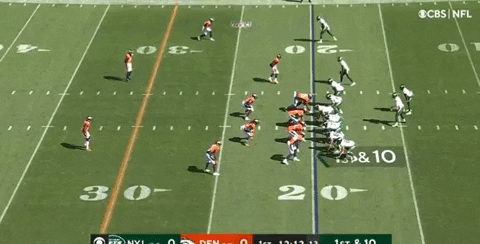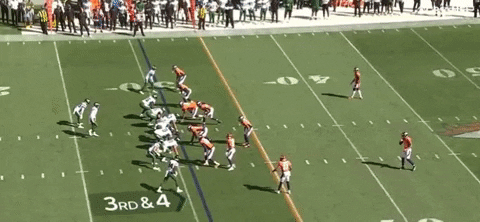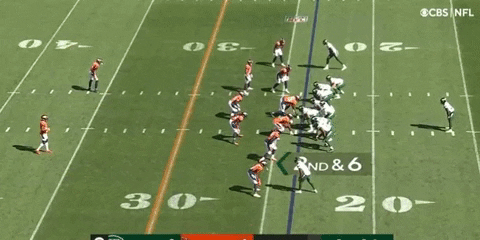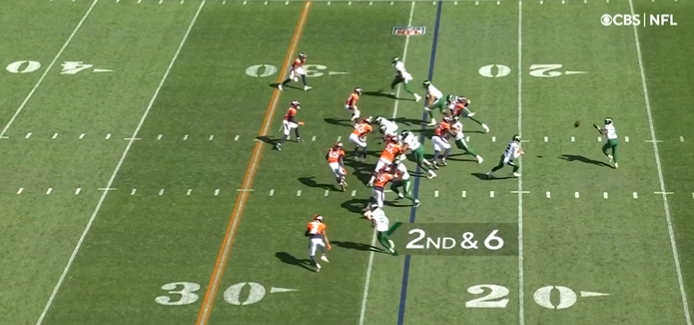QuickFix: Saucy Nuggets from the Jets' loss to the Broncos
We're going to kick off today's analysis with some things you might not have noticed from yesterday's loss to the Broncos:
RPO Speedwagon
After a game like this, where it's so difficult to find any positive signs, it's always useful to focus on some of the things that the Jets were trying to achieve.
One element they've been trying to introduce into their offense is the run-pass option. We'll probably talk about this a lot over the course of the season.
The Jets ran one early on in Sunday's game and it underlines the issue they have in trying to get these things to work. Already struggling with the speed of the pro game, you're asking Zach Wilson to make a split-second decision as to whether to let the running back take the ball or pull it back and make a throw.
Let's look at the mesh point where he has to make the decision:

You can see what the plan is here. If Wilson has the angle to make the pass, he can lead Elijah Moore into the flat and Corey Davis is ahead of him to make a block. This should get Moore to the first down marker and maybe a chance to break a big play if he can break a tackle in space. However, the option is taken away from him because the defensive player is in the backfield already and he's never going to get a clean throw off.
Wilson is left with no option but to hand the ball off to Ace Carter, who gains three yards.

So, it's not really a run-pass option, it's more of a run-pass non-option.
If Greg Van Roten slows up that defender at the line, maybe Wilson pulls it out and makes the easy throw to Moore. It's possible that this isn't a real option at all though. The plan may have been scripted for him to always hand it off and just give the Broncos an RPO-look to keep the defense honest or set something else up later on in the game.
The fact that Van Roten allows his man to beat him on this outside shoulder so easily suggests that this could be the case. By ensuring he has inside leverage, that defender is guaranteed to be sealed on the outside and there's no way he can shoot inside and blow Carter up in the backfield. However, that's the scenario you'd look for which would make the pass option the right choice. Of course, it's quite possible Van Roten just played this poorly and forced Wilson's hand. Either way, this needs to be cleaned up.
If we single out another RPO, this brings us a look at a rare bright spot from Wilson on one of his better plays of the day.

On third down, he hits Tyler Kroft with to keep the chains moving as Kroft makes a nice diving catch. What's really encouraging about this play is that initially the passing lane is blocked but Wilson delays, subtly moves to the left and then fires a clean pass as the elevator doors slide open. That's something positive to build on.
Again, though, you have to question if there was actually an option to this or was it a scripted pass from an RPO-look? If Wilson had handed this ball off, the runner would have been surrounded. The right read? Or were the offensive line playing this to pass protect, knowing that the pass was always going to be thrown?
Also, if Kroft doesn't make the diving catch at full stretch then instead of a "well-placed throw where only the receiver can get it" this instead becomes viewed as an inaccurate wide throw and another Wilson negative.
The wrong kind of "spread offense"
Unfortunately, errors in execution like the one Van Roten had on the first RPO analyzed above started spreading into the running game this week as the Jets were held to just 3.3 yards per carry and 43 yards total.
It's all Carter can do just to get back to the line of scrimmage on this play as a defender is in the backfield quickly.

Freeze-framing this play again gives a good sense of what the Jets were trying to do:

That defender is supposed to be tempted into beating the tight end on his inside shoulder. This then gives that tight end the chance to slow him up or drive him downhill. The run is clearly designed so that Carter can catch the pitch and then get to the edge with two blockers ahead of him.
It looks like a clear first down if this happens but Ryan Griffin is beaten so cleanly that the defender is able to prevent Carter from getting outside and forces him to cut back into traffic.
On a later play, Connor McGovern was tasked with making a reach block but didn't get across in time and a similar run was blown up in the backfield, this time before the back even had a chance to try and cut back.
These are good examples of plays where the initial block is critical and if that is not made, the whole play is doomed to fail. It makes the whole line look bad when the reality is that if that first block can be executed more consistently, we'll see more of the successful runs that were executed in last week's game.
CJ and the bullseye
On defense, CJ Mosley led the Jets again with 10 tackles including a few impressive plays. The best of these saw him light up a runner at the goal line.
However, Mosley was a key to the Broncos' running attack in this game, as they made a concerted effort to get blockers out to the second level in order to cut him off from making the play.
This doesn't necessarily reflect badly on Mosley. If anything it's a sign of respect. The Broncos knew that if they could get to Mosley then the Jets would have to rely on the other back seven players to stop the run and all of the other players are less consistent at tackling and getting to the ball a half step slower so you have a better chance of falling forward or dragging a defender for extra yardage. Also, as successful as this ploy was, the Jets still held Denver to less than three yards per carry on running back carries.
You could criticize the defensive line for not occupying blockers as well as they could have done, but in an attacking front like the one the Jets operate, that's not really their role. However, if they started winning more one-on-one matchups that would at least make it harder for the offensive linemen to peel to the second level without first giving their linemates a helping hand.
In all, though, Mosley was blocked at the second level nine times, including five in the first quarter alone. While he made a couple of great plays after avoiding a second level block and shedding another, that's a lot of negative plays that will be reflected in his own grade even though in practice it really highlights some of the weaknesses in the personnel around him.
It's possible but not certain that Jarrad Davis' return could mean this is no longer a viable plan for opposing offenses. That will be something to watch in a few weeks, but the Jets might struggle until then if his fellow linebackers don't step up.
Better never than late?
Finally, this is no new observation and a common refrain where struggling young quarterbacks are concerned but it was more noticeable than ever this week that Wilson was constantly late on most of his throws.
We've seen this before where a quarterback releases the throw as his man gets separation rather than anticipating and having the ball arrive as his man gets separation.
This led to defensive players being able to jump routes a few times and also a couple of throws over the middle where Wilson rushed the pass and put a bit too much juice on it. That's always risky because if the receiver doesn't catch it, there's usually a safety lingering to pick it off. Wilson got away with this on a throw to Ty Johnson but one of his interceptions was off Braxton Berrios' fingertips in a similar situation.
After the game there was some discussion about Wilson not getting the ball out fast enough and that's usually focused on how often the quarterback was sacked or had to make a throw under pressure. Consider the wobbly throw that Carter dropped at the 30 with green grass ahead of him. An earlier release and that pass would be cleaner and a lot more catchable.
However, the other end of the equation is important too and often overlooked - if you're throwing too late, then timing routes are never going to be open.
At least the issue is obvious here. The Jets face a challenge in terms of fixing it by getting Wilson to play faster without taking risks or falling into traps. If the receivers could step up and earn his trust by bailing him out on bad throws and winning at the catchpoint, that will build trust and hopefully be a step in the right direction.
We'll have some more in-depth analysis for you throughout the rest of today and over the next few days, so keep checking back here early and often.